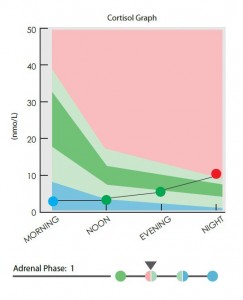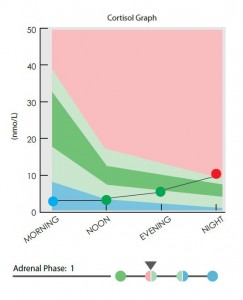ADRENAL STRESS PROFILE
In a Chronic Stress Response all body functions become compromised due to prolonged hormone, immune and metabolic breakdown that can lead to a cascade of chronic degenerative diseases from which the weakened body has a reduced chance to recover. Adrenal exhaustion progresses in three stages and an Adrenal Stress Profile is the most accurate determination of which stage you may find yourself.
The Adrenal Stress Profile uses a non-invasive salivary procedure to monitor the activity of the adrenal cortex and its ability to react to stress. The procedure monitors the circadian variation of the cortisol and DHEA-S levels. An increased cortisol level, a decreased DHEA-S level, or a decrease in the DHEA-S/cortisol ration is an indication of a stressful physical or mental condition.
WHY SALIVA?
Appreciating the reliability of saliva testing is based on understanding the difference between steroid hormones in saliva and in serum. This difference is based on whether or not the hormones are bound to proteins in the medium used for testing. The majority of hormones exist in one of two forms: free (5%) or protein bound (95%). It is only the free hormones that are biologically active, or bio-available, and available for delivery to receptors in the body. Those which are protein bound do not fit the receptors and are considered non-bioavailable. When blood is filtered through the salivary glands, the bound hormone components are too large to pass through the cell membranes. Only the unbound hormones pass through and into the saliva. What is measured in the saliva is the bio-available (free and active) hormone, the clinically relevant portion which will be delivered to the receptors in the tissues of the body.
Salivary hormone levels are expected to be much lower than serum levels, as only the unbound hormones are being measured. When healthcare providers measure serum hormone levels and prescribe hormone replacement therapy based on those results, patients are often overdosed. If the patients are then tested using saliva, the results are extraordinarily high, and confusion results from a lack of correlation between the two methods.This discrepancy becomes especially important when monitoring topical, or transdermal, hormone therapy. Studies show that this method of delivery results in increased tissue hormone levels (thus measurable in saliva), but no parallel increase in serum levels. Therefore, serum testing cannot be used to monitor topical hormone therapy.
WHO SHOULD BE TESTED?
Both men and women experience changes in hormone levels with age. Sometimes those changes result in unpleasant symptoms that demand attention. Often, the changes are more subtle yet there is still an impact on overall health. Hormone testing is applicable for:
- Men and women concerned with changing hormone levels as a result of age.
- Cycling women experiencing PMS symptoms, perhaps related to a hormonal imbalance.
- Peri and post-menopausal women concerned with their estradiol and progesterone levels for replacement considerations.
- Those wishing to monitor their hormone levels following replacement therapy (oral, sublingual or topical), and subsequently regulate their supplement levels.
- Anyone with symptoms involving fatigue, insomnia, stress, immunity problems, blood sugar problems, and overweight should be tested for cortisol levels as well as “sex” hormones.
Men and women of any age who are having symptoms of hormone imbalances should test for all hormones that may be associated with their symptoms. Men and women over the age of forty may want to do a baseline test. Frequently imbalances will be detectable for a time period before symptoms gain attention.
WHICH HORMONES NEED TESTING?

What are the different stages of adrenal fatigue?
In Stage I, the Alarm Reaction, of adrenal insufficiency, cortisol and DHEA remain at normal levels. The adrenal glands are able to handle the stress being placed on the body. Hormone production may be somewhat affected but for the most part, the body is able to produce enough cortisol and DHEA to compensate. At this stage, no dysfunction either physical or physiological is noticeable. Though the adrenal glands are working overtime, this state is rarely seen as a pathological condition.

In Stage II, the Resistance Response, they body is under constant stress and the cortisol levels continue to rise while DHEA levels begin to gradually decrease. The adrenal cortex (the outer section) produces corticosteroids for this resistance response. Normal activity is carried on, but the sense of fatigue at the end of the day is acute and recovery takes longer. As the adrenals begun to struggle, symptoms can start to appear such as nervousness, disruptions in sleep patterns, body aches, digestive problems and weight gain. These are all signs that the adrenals are becoming sluggish. The thyroid gland is usually affected at this stage.
When a person reaches Stage III, Adrenal Exhaustion, anxiety and exhaustion begin to appear simultaneously. This is an advanced stage of adrenal exhaustion characterized by decreased total cortisol output. The adrenal glands are now exhausted to the point that even though there is ongoing hyperstimulation (high ACTH); they continue to lose their capacity and reserve to produce enough cortisol in response to stress. With the level of DHEA continuing to drop, sleeplessness may result. The eventual result is a crash of the hypothalamic-pituitary-adrenal axis (HPAA) in which essential neuroendocrine feedback loops are unable to return the system to homeostasis. Blood sugar levels plummet, and this leads to further intolerance to stress as well as increasing mental, physical and emotional exhaustion, and ultimately collapse.
Stage IV, Failure, is the final stage and although rarely seen, it is a total failure of the adrenal glands in response to stress. When in a stressful situation, people are now susceptible to cardiovascular collapse and even death. The adrenals have ceased to function for the most part, and little can be done to restore balance.
Adrenal Function Tests have been specifically developed to assess the level of patients’ adrenal function. Since cortisol levels ideally fluctuate according to a daily circadian, peaking in the morning and decrementing to a low at bedtime only to rise again over night, four time-specific saliva samples are collected during a “normal” day (morning, noon, afternoon and nighttime). Testing can include DHEA-S levels, one taken on the noon sample and one on the afternoon sample plus morning estradiol, estriol and testosterone as well as bedtime progesterone and melatonin.
For more information on Salivary Hormone Testing, please visit Labrix.
Follow us on instagram
BLOG
Become an educated consumer with our Indigo Blogs and prevent dis-ease.
Our Doctors have been featured in:









